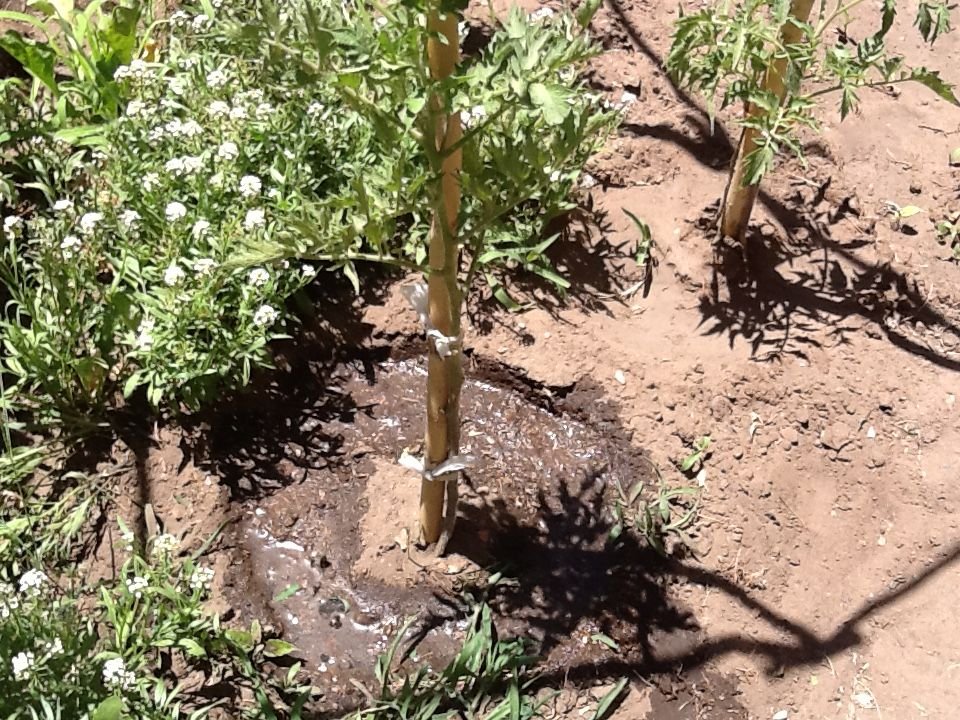My vegetable garden and my garden, my two green friends that help me and allow me to relax [ENG] / Mi huerta y mi jardín, mis dos amigos verdes que me ayudan y permiten relajarme [ESP].
0 comments

My vegetable garden and my garden are the two places that best represent my personal universe and are my escape valve when I am too stressed by my work and I want to find a place where I can find peace and quiet.
But they also represent, especially the vegetable garden, the best way to organise my life and to eat healthy, natural, organic and high quality products.
In previous posts I had told you about the effort of preparing the soil (I live in a mountainous area) and therefore the soil, although it has excellent nutritional elements, is also composed of clay, clay and many stones, big and small.
Therefore, when I have to sow more than with the spade, I have to grab the pickaxe to extract the stones first and then remove it with the spade, rake it, clean it of all the impurities and sow it.

The next step is to sow and then wait for the seedlings to grow, take care of the pests, insects and birds that do not eat them and with some luck and a lot of effort, after a couple of months (in some cases like leafy vegetables such as lettuce, chard, parsley, etc.) to harvest the beautiful fruits.
Composting is essential. I prepare the soil in a special wooden container I built myself where I put organic waste, dry straw and other biodegradable elements.
It takes about a year for all these components to transform into rich humus, but it is really worth the effort.
It contributes a lot to enriching the soil.
So I built myself a small greenhouse where I grow vegetables all year round.

There are other products where you have to wait much longer. Months. For example squash, garlic, onions, beetroot, etc.
Aromatic plants have a different development: some take months to reach their fullness (oregano), others take a couple of years (rosemary), but after that, as they are perennial plants, they do not need to be replanted. They last for several years and are simply pruned every time they are used as an ingredient in food.
Today I would like to show you the fruits of that labour.



And the final step is when these products are transformed into a delicious lunch!


Mi huerta y mi jardín son los dos lugares que representan mejor que nada mi universo personal y que son la válvula de escape cuando estoy demasiado estresado por mi trabajo y quiero buscar un lugar donde refugiarme en paz y tranquilidad.
Pero además de ello representan, especialmente la huerta, el mejor modo para organizar mi vida y comer productos sanos, naturales, ecológicos y de excelente calidad.
En post anteriores les había comentado sobre el esfuerzo de preparar la tierra (vivo en una zona de montaña) y por lo tanto la tierra si bien tiene excelente elementos nutritivos también está compuesta por greda, arcilla y muchas piedras, grandes y pequeñas.
Por lo tanto cuando debo sembrar más que la pala debo agarrar el pico para extraer primeros las piedras y luego si removerla con la pala, rastrillarla, limpiarla de todas las impurezas y sembrarla.

El paso inmediato es sembrar y a partir de ese momento esperar que nazcan las plantittas, cuidarla de las plagas, los insectos y los pájaros que no se las coman y con algo de fortuna y mucho esfuerzo llegar después de un par de meses (en algunos casos como las hortalizas de hoja tipo lechuga, acelga, perejil, etc.) a recoger los hermosos frutos.
El compostaje es fundamental. Preparo la tierra en un contenedor especial de madera construído por mi mismo donde echo residuos orgánicos, paja seca y otros elementos biodegradables.
Hay que esperar cerca de un año para que tods estos componentes se transformen en rico humus, pero el esfuerzo vale verdaderamente la pena.
Contribuye muchísimo a enriquecer la tierra.

De esta manera me construí un pequeño invernadero donde cultivo hortalizas todo el año.
Hay otros productos en los cuáles hay que esperar mucho más tiempo. Meses. Por ejemplo zapallo, ajo, cebolla, remolacha, etc.
Las plantas aromáticas tienen un desarrollo distinto: algunas llevan meses hasta alcanzar su plenitud (orégano) otras en cambio un par de años (romero), pero a partir de ese momento como son plantas perennes no es necesario volver a resembrarlas. Duran varios años y se podan simplemento cada vez que las utilizamos como ingrediente de alguna comida.
Hoy les quiero mostrar los frutos de ese trabajo.



Y el paso final es cuando estos productos se transforman en un delicioso almuerzo!




Comments